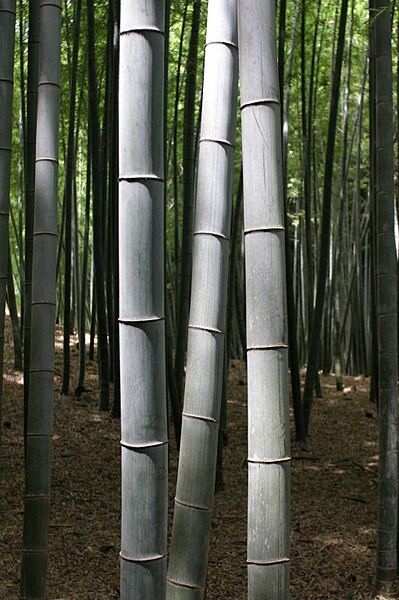
As one of nature’s most renewable gifts, bamboo has been used in many ways since the beginning of time. In modern times, it has become the wood of choice for making both decorative and practical items that are aesthetically pleasing as well as environmentally friendly. Bamboo will give you the natural beauty of hardwood flooring in your home without the detrimental effect on the environment. Bamboo is one of the hardest natural materials available for flooring use, and is an excellent alternative to tree wood, because of its extremely fast growth speed. Because bamboo is a rapid growing grass, and not wood, it can be harvested every 3-5 years, unlike 15-25 years for most tree wood, or up to 120 years for oak! Here are couple interesting facts about bamboo: • Bamboo is the fastest-growing plant on Earth. It can surge skyward as fast as 121 cm (47.6 inches) in 24-hours
• Bamboo is the fastest-growing plant on Earth. It can surge skyward as fast as 121 cm (47.6 inches) in 24-hours
• It can also reach maximal growth rate exceeding one meter (40 inches) per hour for short periods of time
• 6 million people in China work in bamboo and 600 million people worldwide rely on income from it
Growth speed makes bamboo a very environmentally friendly product for flooring. When it’s harvested, it grows back – just like your lawn. But unlike your grass, bamboo is hard – 25% harder than red oak, but equally as strong. Bamboo is also blessed with colorful tones and distinctive grains. Such sustainability, strength and beauty are major reasons why bamboo has grown to become one of the most popular flooring choices in America. Bamboo is found in diverse climates, ranging from cold mountains to hot tropical regions. The majority of today's bamboo flooring products originate in China, and other areas of Asia. There are about 1,000 species of bamboo. The species of bamboo used for flooring is commonly known as "Moso.” The manufactured bamboo flooring commonly found in North America is processed by steaming, splitting and flattening the bamboo and then allowing it to dry. The bamboo is then laminated in layers with glue under high pressure. Manufactured bamboo floors are typically made available in planks with either vertical- or horizontal-grain orientation. The two major colors are natural (similar to beech) and carbonized (similar to oak). The process of steaming bamboo material under a controlled pressure and temperature is called carbonization. During this process bio-organisms and sugars break down allowing it to become brownish in color. The natural and carbonized bamboo floors are typically referred to as solid bamboo, although, in fact, the structures are layered, similar to plywood.
Bamboo is found in diverse climates, ranging from cold mountains to hot tropical regions. The majority of today's bamboo flooring products originate in China, and other areas of Asia. There are about 1,000 species of bamboo. The species of bamboo used for flooring is commonly known as "Moso.” The manufactured bamboo flooring commonly found in North America is processed by steaming, splitting and flattening the bamboo and then allowing it to dry. The bamboo is then laminated in layers with glue under high pressure. Manufactured bamboo floors are typically made available in planks with either vertical- or horizontal-grain orientation. The two major colors are natural (similar to beech) and carbonized (similar to oak). The process of steaming bamboo material under a controlled pressure and temperature is called carbonization. During this process bio-organisms and sugars break down allowing it to become brownish in color. The natural and carbonized bamboo floors are typically referred to as solid bamboo, although, in fact, the structures are layered, similar to plywood.
Bamboo flooring is available in countless colors and styles, which will compliment any interior design. From ultra-contemporary chic, to a more traditional, classic style, natural bamboo flooring will give you a truly unique look.
With high sustainability and environmentally sound origins, bamboo flooring has become a great choice for those looking to decorate their homes or workplaces with the beauty of a wood floor while being environmentally conscious. Because of this, consumers are increasingly choosing to install bamboo flooring in place of traditional hardwood.
There is no question that bamboo is a renewable resource and has been recognized as a “green material.” Quoting Environmental Building News, “Environmentally, it’s hard to argue with a wood substitute that matures in three years, regenerates without need for replanting, and requires minimal fertilization or pesticides.”
Visit GateWoodFloors.com and check out our selection of bamboo. It’s one of the biggest selections you’ll find anywhere!
Monday, August 4, 2008
Bamboo
| alternative flooring materials, bamboo flooring, eco-friendly, engineered wood flooring, environmentally friendly, hardwood species, renewable resource, wood, wood species Monday, August 4, 2008
Subscribe to:
Post Comments (Atom)

1 comment:
since bamboo is a earth friendly flooring, it makes sense to clean it with a eco friendly
like this one
Post a Comment